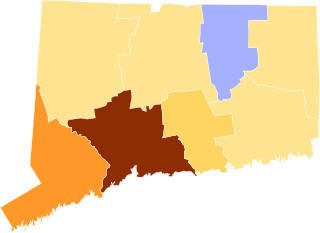
LaFayette Sabine Foster was an American statesman and jurist from Connecticut. He served in the United States Senate from 1855 to 1867 and was a judge on the Connecticut Supreme Court from 1870 to 1876. Elected as the president pro tempore of the United States Senate six weeks prior to the assassination of Abraham Lincoln on April 14, 1865, he was the acting Vice President of the United States after Lincoln's death for nearly two years, and received the salary of the position.

Horatio Seymour was an American politician. He served as Governor of New York from 1853 to 1854 and from 1863 to 1864. He was the Democratic Party nominee for president in the 1868 United States presidential election, losing to Republican Ulysses S. Grant.

The 1854 New York state election was held on November 7, 1854, to elect the governor, the lieutenant governor, a Canal Commissioner and an Inspector of State Prisons, as well as all members of the New York State Assembly.

The 1850–51 United States Senate elections were held on various dates in various states. As these U.S. Senate elections were prior to the ratification of the Seventeenth Amendment in 1913, senators were chosen by state legislatures. Senators were elected over a wide range of time throughout 1850 and 1851, and a seat may have been filled months late or remained vacant due to legislative deadlock. In these elections, terms were up for the senators in Class 1.

The 1860 Connecticut gubernatorial election was held on April 2, 1860. Incumbent governor and Republican nominee William Alfred Buckingham defeated former governor and Democratic nominee Thomas H. Seymour with 50.30% of the vote.

The 1856 Connecticut gubernatorial election was held on April 7, 1856. Incumbent governor and American Party nominee William T. Minor defeated former congressman and Democratic nominee Samuel Ingham and former Comptroller of Connecticut and Republican nominee Gideon Welles with 38.99% of the vote.

The 1855 Connecticut gubernatorial election was held on April 2, 1855. Former state legislator and American Party nominee William T. Minor defeated former congressman and Democratic nominee Samuel Ingham and incumbent governor and Whig nominee Henry Dutton with 43.51% of the vote.

The 1854 Connecticut gubernatorial election was held on April 3, 1854. Former state legislator and Whig Party nominee Henry Dutton defeated former congressman and Democratic nominee Samuel Ingham and former congressman Charles Chapman with 31.89% of the vote.

The 1853 Connecticut gubernatorial election was held on April 4, 1853. Incumbent governor and Democratic Party nominee Thomas H. Seymour defeated former state legislator and Whig nominee Henry Dutton and former state legislator and Free Soil nominee Francis Gillette with 51.01% of the vote.

The 1852 Connecticut gubernatorial election was held on April 5, 1852. Incumbent governor and Democratic Party nominee Thomas H. Seymour defeated incumbent Lieutenant Governor and Whig nominee Green Kendrick with 50.39% of the vote.

The 1851 Connecticut gubernatorial election was held on April 7, 1851. It was a rematch of the 1850 Connecticut gubernatorial election. Incumbent governor and Democratic Party nominee Thomas H. Seymour defeated former state legislator and Whig nominee Lafayette S. Foster with 48.94% of the vote.

The 1849 Connecticut gubernatorial election was held on April 2, 1849. Former congressman and Whig nominee Joseph Trumbull defeated former congressman and Democratic nominee Thomas H. Seymour as well as former Senator and Free Soil nominee John M. Niles with 49.35% of the vote. Niles had previously been the Democratic nominee for this same office in 1840.

The 1848 Connecticut gubernatorial election was held on April 3, 1848. Incumbent Governor and Whig nominee Clark Bissell was re-elected, defeating former congressman and Democratic nominee George S. Catlin with 50.38% of the vote.

The 1846 Connecticut gubernatorial election was held on April 6, 1846. Former congressman and Democratic nominee Isaac Toucey was elected, defeating former state legislator and Whig nominee Clark Bissell with 47.54% of the vote.

The 1844 Connecticut gubernatorial election was held on April 1, 1844. Former state legislator, Amistad lawyer and Whig nominee Roger Sherman Baldwin was elected, defeating incumbent governor and Democratic nominee Chauncey Fitch Cleveland with 49.41% of the vote.

The 1842 Connecticut gubernatorial election was held on April 4, 1842. Former Speaker of the Connecticut House of Representatives and Democratic nominee Chauncey Fitch Cleveland was elected, defeating incumbent governor and Whig nominee William W. Ellsworth with 49.94% of the vote.

The 1841 Connecticut gubernatorial election was held on April 5, 1841. Incumbent governor and Whig nominee William W. Ellsworth was re-elected, defeating businessman and Democratic nominee Francis H. Nicoll with 55.79% of the vote.

The 1834 Connecticut gubernatorial election was held on April 7, 1834. Former senator and Whig nominee Samuel A. Foot was elected, defeating incumbent governor and Democratic nominee Henry W. Edwards with 49.83% of the vote.

The 1850 New York gubernatorial election was held on November 7, 1850. Incumbent Governor Hamilton Fish was not a candidate for re-election. Washington Hunt was elected to succeed him, defeating Horatio Seymour in the latter's first run for governor. Seymour would go on to serve two terms in office and be nominated for President of the United States in 1868.

The 1849–50 Massachusetts gubernatorial election consisted of an initial popular election held on November 12, 1949 that was followed by a legislative vote held on January 7, 1850. The ultimate task of electing the governor had been placed before the Massachusetts General Court because no candidate received the majority of the vote required for a candidate to be elected through the popular election. Incumbent Whig Governor George N. Briggs won the legislative vote and was therefore elected, defeating Democratic nominee George S. Boutwell and Free Soil nominee Stephen C. Phillips.























